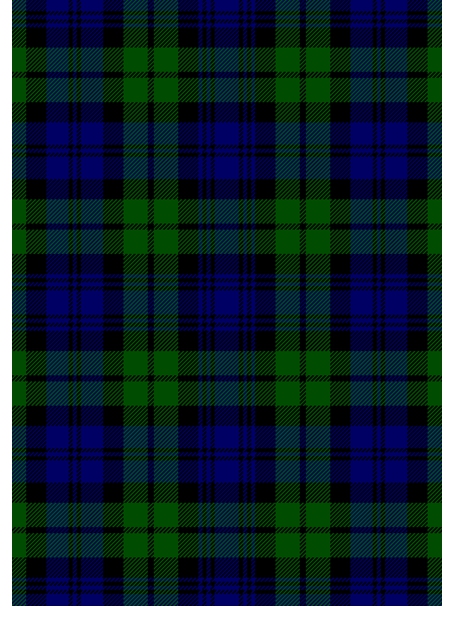The Tartans
Some Tartans Associated
with the Clan Grant
James Grant, historian,
Clan Grant Society – USA
(High-quality PDF file for printing)
NOTE: Click on any image to see it's full size.
It is the prerogative of the chief of a clan to identify and authenticate the pattern to be known as the tartan of his clan. Our Chief, the Right Honorable Lord Strathspey, Sir James Patrick Trevor Grant of Grant, Baronet, selected the tartan designated by Plate XIX in The Tartans of the Clans of Scotland.
The tartan of the Black Watch, the Royal Highland Regiment, also has a long association with the Clan Grant. A precursor of the Black Watch tartan was worn by the six Independent Companies formed in the highlands in 1725 by General (later Field Marshal) George Wade. The Independent Companies were called Am Freiceadan Dubh, the Black Watch, almost certainly because of the dark, somber colors of their plaids.
One of the companies was originally recruited and commanded by Col. William Grant of Ballindalloch, and after his death in 1733, by the brother of the Chief of Grant, Major George Grant. It is almost certainly because of this early association that the Black Watch tartan also became known as the ‘Grant Hunting tartan’.
Other Tartans Associated
with the Clan Grant
before the Victorian Era
There were essentially five genres or styles of tartan known to have been associated with the Clan Grant in the 18th century.
I. “Tartan of red and Greine sett broad springed” – 1704
Ludovick Grant, Chief of the Clan Grant, ordered his tenants and members of his clan to be prepared to muster upon forty-eight hours notice in ‘…Heighland Coates trewes & short hose of tartane of red and Greine sett broad springed.’ This instruction from the Laird of Grant’s Regality Court Book, dated July 20th, 1704, is the first known reference to a tartan associated with the clan. (General Register Office, Edinburgh, RH 11/34/2)
Although there was no specific pattern given, red and green tartans were apparently commonplace in Strathspey during the first decade of the 18th century. No known remnant of these tartans remain today, but it is possible that they resembled the setts featured in the now-famous portraits of the Laird’s Champion and the Laird’s Piper, painted in 1714 by Richard Waitt.
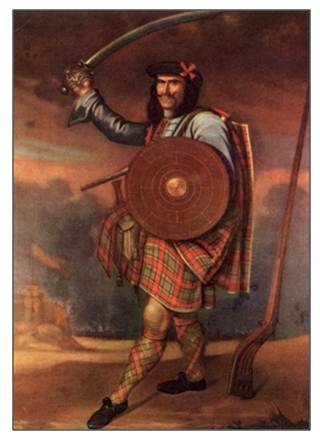
The Reidhaven Trust |
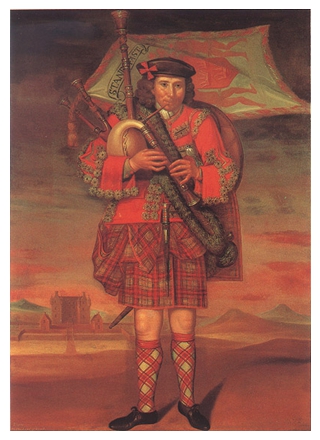
National Museum of Scotland |
|
|
Alister Grant Mohr, the Laird’s Champion, |
William Cumming, the Laird’s Piper, |
II. A Dark Blue-Green-Black Sett – 1725
As previously mentioned, another pattern inextricably linked to the Clan Grant was a blue-green-black tartan worn by members of the six Independent Companies formed in the highlands by General George Wade, circa 1725. The exact sett of the tartan is not known and no remnants of it have survived into the 21st century, but it was almost certainly the forerunner of the sett known today as the Black Watch.
In fact, the Independent Companies were called Am Freiceadan Dubh, the Black Watch, almost certainly because of the dark, somber colors of their plaids. Large quantities of this tartan were woven in Strathspey by over forty weavers on the estates of the Chief of Grant and the Laird of Ballindalloch during the years 1725-1739. In a well-known portrait of Robert Grant of Lurg, circa 1769, the sitter is featured in a tartan coat and plaid said to be the uniform he had worn as a sergeant in the Grant Independent Company many years before. The Black Watch tartan continues to be worn today by the Clan Grant as its ‘undress’ or ‘hunting’ tartan.
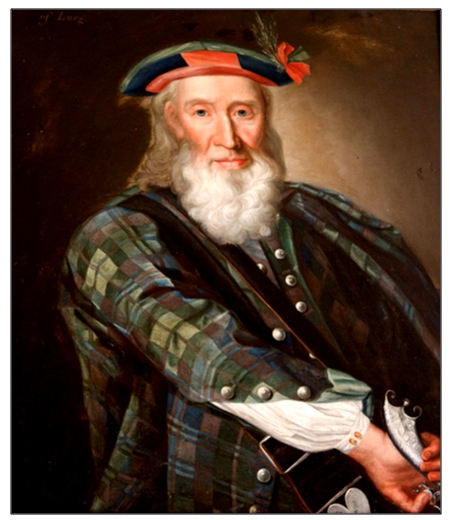
Courtesy of The Earl of Seafield |
|
Portrait of Robert Grant of Lurg, |
III. Tartans with Green and Blue Stripes on a Red Field – (1730-1780)
Another genre or style of ‘broad-springed’ red, blue and green tartans can be traced to several districts in Strathspey. Although not identical, these tartans are from the period 1730 – 1780 and share similar design characteristics. They are primarily from Rothiemurchus and the parish of Abernethy, but might also be indigenous to other locales in Strathspley. Their principal common trait is that they feature large stripes of blue and green on a field of red.
A number of examples of this genre have survived into the 21st century. Four are featured in the computer simulations below.
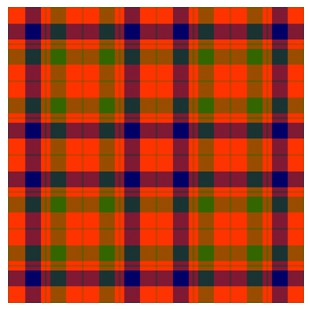 |
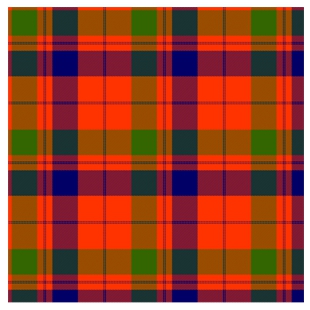 |
|
|
18th Century Plaid from Rothiemurchus recorded |
An 18th Century Asymmetric Offset |
|
 |
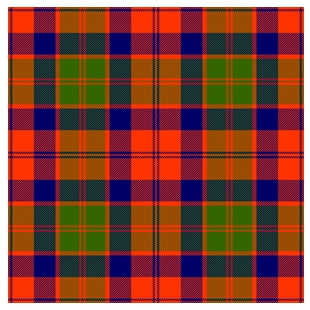 |
|
|
18th Century Curtain Plaid from Nethy Bridge, |
18th Century Plaid from Rothiemurchus |
IV. Tartan of the 1st Strathspey Fencible Regiment – 1793
At least five settings of a tartan named simply ‘Grant’ were recorded in the records of William Wilson & Sons. Wilson & Sons was a textile mill at Bannockburn, near Stirling, that supplied large quantities of tartan to the British regiments, as well as for Scottish retail trade and export. Many of their patterns or setts were documented in the Key Pattern Book of 1819, although some probably originated in the late 18th century – perhaps as early as the 1780’s.
The tartan (below) was derived from the ‘government’ or Black Watch sett, but with a thin yellow over-stripe flanked on each side by thin red stripes. It was almost certainly the breacan an fhéilidh or belted plaid of the 1st Strathspey Fencible Regiment – and perhaps the 97th Regiment of Foot, as well. Both regiments were raised by Sir James Grant of Grant, Baronet, in the last decade of the 18th century. No specimen of the original tartan has survived into the 21st century.
The pattern was recorded by Wilsons in a variety of settings, as was the case with most military tartans. The officers’ plaids were woven in finer yarn than the non-commissioned officers, and the NCO’s plaids were of better quality than the privates’.
This tartan has been erroneously called ‘Hunting Grant’. The Grant hunting tartan, of course, is the same sett known as the Black Watch.
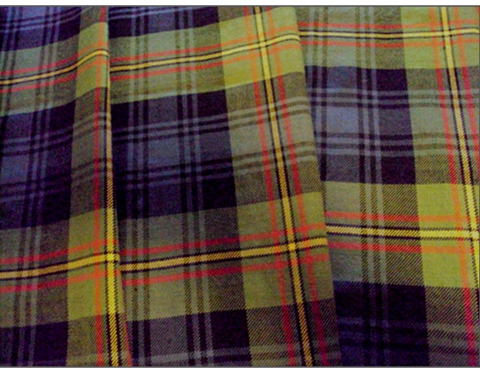
Handwoven by the author, February 2013 |
|
‘Grant Tartan’ from William Wilson & Sons’ Key Pattern Book (1819), |
V. The ‘New Bruce’ and the ‘Grant Kilt’ Tartans – late 18th/early 19th Century
The super-fine ‘New Bruce’ tartan in the Key Pattern Book of William Wilson & Sons was the first red tartan specifically associated with the Clan Grant. In 1819, Patrick Grant of Redcastle ordered 200 yards of the New Bruce pattern, stating that “…it was the tartan of his own clan.” The large purchase was almost certainly occasioned by his imminent marriage to Catherine Sophia Grant, a distant cousin.
The only surviving specimen of the New Bruce tartan is in the collection of General Sir William Cockburn of Cockburn, Baronet. Cockburn’s collection dates to circa 1815. That sample is labeled ‘Drummond’ and is currently housed in the Mitchell Library in Glasgow. The clans Drummond and Grant share the same red tartan today.
The New Bruce sett featured large expanses of red and green with relatively small stripes of navy and light blue. New Bruce was the forerunner of another Wilson pattern known as ‘Grant Kilt’, which probably came into being with the dawning of the 19th century. The large red and green color bars of the New Bruce sett were scaled down about 50% in the ‘Grant Kilt’ tartan to render it more suitable for the feilidh-beag, a late 18th century innovation known as the man’s kilt.
The Grant Kilt tartan was essentially the same pattern known today as ‘Modern Red Grant.’
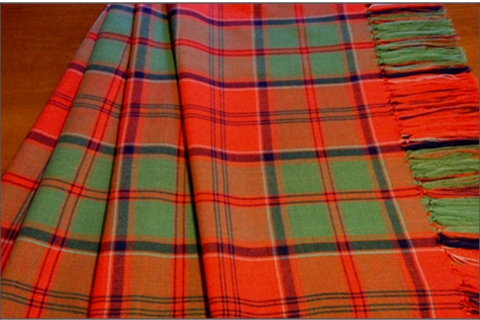
Handwoven by the author, August 2014 |
|
‘Grant Kilt’ Tartan |
![]()
![]()
![]()
[This article is condensed from a more comprehensive research report, Historical Notes on Some Tartans Associated with the Clan Grant, by James Grant, historian, Clan Grant Society – USA.]


